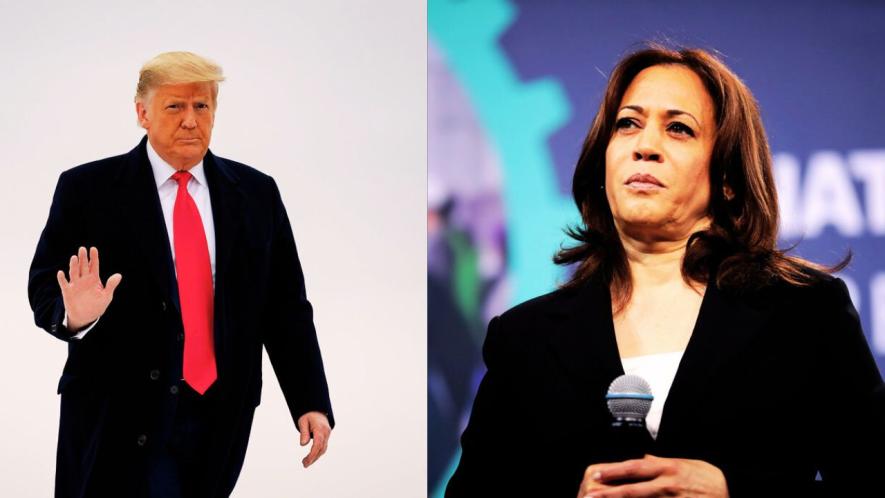2024 US Presidential Polls: An Undemocratic System

Image Courtesy: Flickr
The presidential election process in the United States is unique for a number of reasons. First, it is possibly the only country in the world where a candidate can lose the presidential election even if they obtain a majority of the votes (popular vote). This is the case since a candidate has to win a majority of 270 votes in an electoral college of 538. Each of the 50 states and the capital, Washington District of Columbia, are each allotted a certain number of electoral college votes ostensibly based on population, with each of the states having at least 3 electoral college votes.
This system, supplemented by voter suppression that disproportionately impacts minorities adversely, currently tends to favour the Republican Party, which politically dominates rural or semi-urban states and areas with small populations. Further, within many (but not all) states, the winner of the popular vote of that state receives all the electoral college votes allotted to that state. This results in the irrelevance of the votes of other candidates in that state.
However, the “centrist” leadership of the Democratic Party has tended to acquiesce with this exclusionary system unlike the progressive wing of the Democratic Party. This is evident from the voting records of congresspersons of the Democratic Party in almost every legislation that poses even the mildest challenge to big business. In each such case, a sufficient number of Democratic Party congresspersons can always be found to scuttle the relevant legislation.
In order to try and explain this acquiescence, it may be apposite to underline the second unique feature of the electoral system of the US, namely, that there are only two electorally significant parties, i.e., the Democratic Party and the Republican Party. This two-party system has emerged out of a complex historical process which may be approximately summarised as follows: unlike other countries with many political parties where the reformist leadership of the Left of Centre parties by and large compromises with capital, in the US, capital de facto dominates both these parties to an extent that exceeds what is the case in any other country.
As long as this two-party system and electoral college process exist, it is extremely difficult for any Left wing political movement to become electorally significant. Therefore, many Left forces in the US tend to (but not always) advocate for support to the Democratic Party presidential candidate in order to defeat the Right wing Republican Party, which is currently led by Donald Trump and currently metamorphosing into a neo-fascist organisation.
Due to the joint impact of the two-party system and the electoral college-based presidential election process (which is undemocratic), the voting in a small number of states, known as battleground states, have acquired outsized influence. In other words, in the non-battleground (or safe) states, the number of swing voters who switch their voting choice between the two major parties is not large enough to change the party candidate who wins that state.
In the battleground states, it is the swing voters of these states who are decisive in determining the victor in that state. Therefore, the entire focus of political campaign in the presidential election process is directed toward the swing voters of these battleground states.
The Political Economy Context
The current presidential contest, which is principally between Kamala Harris of the Democratic Party and Donald Trump, exemplifies the issues highlighted in the preceding paragraphs. However, both the process and outcome of the presidential election is the joint outcome of the encounter between the prevailing political economy context and the extant undemocratic electoral system in the US.
Let us, therefore, briefly set out the political economy setting of the current presidential election. First, the imperialist hegemony of the US is declining due to the end of the super imperialist (or unipolar) interlude exemplified, above all, by the rise of China and the return of Russia.
Second, the ongoing process of neoliberalisation in the US has resulted in a severe squeeze on the working people since the 1970s and has disproportionately impacted minorities and women. This has involved stagnation in wages relative to what was the case before the 1970s, decline in trade unions (though there has been some recent resurgence), the rise of a racially and gender wise differentiated precariat, out migration of production capacity especially in activities involving the relatively lower and middle reaches of the technological ladder etc.
Initially, this process benefited big business in the USA since these multinational corporations got these commodities produced in areas principally in and around China (due to labour arbitrage) but the bulk of the profits that were realised accrued to these very same multinational corporations of the USA in the form of rentier incomes (deriving from the actions of international financial capital centred in the US), merchant profits, royalties on “intellectual property” etc.
However, as China ascended the technological ladder (in spite of counter moves of the government of the US), capitalists in the US, too, felt a downward pressure on their profits as regards both merchant profits and royalties on “intellectual property”. Needless to say, this downward pressure on profits was disproportionately felt by small enterprises.
The reaction of both parties to this unfolding political economy context has tended to converge (but not fully) in a regressive direction. The Republican Party, especially Trump, has firstly sought to scapegoat (non-white) immigrants for the travails of the working people along two lines. One, these non-white immigrants, it is claimed, reduce employment and wages of residents. In fact, most of these non-white immigrants end up doing those types of work and at wages both of which are undesirable to working residents of the US. Some high wage jobs are undertaken by immigrants since there are no residents available to undertake these jobs.
Two, it is claimed that the Democratic Party-led government diverts public resources toward these non-white immigrants. This claim is specious since these accounts are at best anecdotal and there is no accounting of the amounts involved as a share of total social welfare expenditure of the government of the US. However, this xenophobia neatly dovetails with the explicit racism of the Republican Party.
The Democratic Party, acting as the “Left” wing of capital in the US is unwilling to counter the Republican Party by making the case for an expanded social welfare system that is financed by taxation of the super-rich. Therefore, the Democratic Party’s implicit racism has tended to involve a step-by-step acquiescence in this item in the neo-fascist agenda of the Republican Party.
Therefore, none of the “centrist” leaders of the Democratic Party are willing to advocate for policies that can directly combat the racism of the Republican Party, including increase of the minimum wage, universal health insurance coverage, public financing of universal child and elder care etc.
As far as the relative decline of the imperialist hegemony of the US is concerned, both parties have basically the same set of policies though the public articulation and temporal sequencing of these policies differs between both parties. Objectively, the US is incapable of strategically contending with both China and Russia simultaneously. Therefore, the government of the US seems to be coming around to the view that military conflicts in Ukraine and West Asia ought to be wound down (without too much loss of face) so that its resources may be relatively concentrated against China.
The ostensible difference in the foreign policy platform of both parties appears more accentuated than is the case due to the fatuousness involved in Donald Trump’s articulation of his campaign points in this regard. The foreign policy record of Trump’s presidential term between 2017 and 2021 is ample testimony of the validity of the proposition of a de facto consensus on foreign policy among both parties.
The relative decline of the US, briefly discussed in the preceding paragraphs, has been geographically uneven within the country. In many states that are in the interior of the country, the decline in manufacturing has not been even partly compensated (in terms of output but not by equivalent jobs in terms of wages and working conditions) by the rise of service sector activities unlike in both the coastal areas.
The Battleground States
In the light of the issues we have highlighted, let us now examine some salient features of the ongoing presidential process in the US with special reference to the battleground states. We examine data regarding electoral college voting, popular vote and recent poll surveys. Besides, we also look into the five socio-economic characteristics of the US states, including rural population, per capita income, unemployment, race, and education level by bachelor degree and above.
Many states have had close presidential votes in the past 40 years. Over the past eight presidential elections, 26 states were won by less than a three-point margin in at least one election. This includes Florida and Nevada, which had tight margins in five of the last eight elections (1992–2020).
Figures 1 and 2 show the number and names of the US battleground states where the winning party was different from previous presidential elections during the period 1992-2020. Figure 1 shows that the highest number of battleground states was in 1992 at 22 but this reduced to six in 2016 and 5 in 2020.
Figure 2 shows 26 battleground states during the period 1992-2020. The highest number of switches in the identity of the winning party are as follows: Nevada (5), Florida (5), North Carolina (4), New Hampshire (4), Pennsylvania (4), Wisconsin (4), Georgia (3), Ohio (3), Montana (3), and Arizona (3), reflecting a range 3-5 for the 10 battleground states and another 16 states reflected a change of 1-2 for the same metric.
The 10 battleground states in the range of 3-5% can be analysed here for the vote shares of both parties during the presidential elections of both 2020 and 2016. Figures 3 and 4 show the vote shares. Figures 5, 6 and 7 show the shares of rural population, per capita income and unemployment rate to examine the voting preference of states.
The share of popular votes for Biden in the top-10 battleground states in 2020 was as follows: Nevada (50.1), Florida (47.9), North Carolina (48.6), New Hampshire (52.7), Pennsylvania (49.9), Wisconsin (49.4), Arizona (49.4), Montana (40.5), Ohio (45.2), and Georgia (49.5). Among these top-10 battleground states, six had more than 49 % popular vote share for Biden, with two states having more than 50% (Nevada and New Hampshire).
The corresponding vote shares for Trump are: Nevada (47.7), Florida (51.2), North Carolina (48.6), New Hampshire (45.4), Pennsylvania (49.9), Wisconsin (48.8), Arizona (49.1), Montana (56.9), Ohio (53.3), and Georgia (49.2).
Six of the top 10 battleground states have more than 49% popular vote shares for Trump. Further in two states, he had more than 50% share (Florida and Montana). It may be not unimportant in this context to examine the share of rural population and unemployment rate in these states.
Battleground States Voting in Recent Polls
Let us now focus on those states that voted for Joe Biden in 2020 and Trump in 2016. These states include Arizona, Georgia, Michigan, Pennsylvania, and Wisconsin. Slim victory margins in elections also indicate that a state could have been won by either party. In 2020, seven states were won by a margin of three percentage points or less. These included the five previously mentioned states as well as North Carolina and Nevada.
Figures 3 and 4 show that Nevada and New Hampshire are battleground states that favoured Biden while Florida and Montana favoured Trump during 2020 with more than 50% popular votes. Figure 5 shows the shares of rural population in Florida (8%) and Montana (48%) and New Hampshire (44%) and Nevada (6%). The share of rural population is one (but not the sole) determinant of support for the Republican Party
Figure 6 shows per capita income of these four state,s namely Arizona, Georgia, Michigan, Pennsylvania, and Wisconsin and were won by a margin of three percentage points or less. These states included the five above states, in addition to North Carolina and Nevada.
Rural Populace, Per Capita Income, Unemployment, Race
It is important to examine the shares of rural population of these seven states: Arizona (11%), Georgia (27%), Michigan (28%), Pennsylvania (24%), Wisconsin (17%), North Carolina (34%) and Nevada (6%) as shown in Figure 5.
Figure 6 shows the Per Capita Income of these four states are as followed: Florida ($69,000-20th rank) and Montana ($65,000 -30th rank) and New Hampshire ($79,000 -10th rank) and Nevada ($66,000 -26th rank), reflecting lower rankings of these states in the US.
Typically (but not always) higher per capita income states tend to vote Democrat while lower per capita income states tend to vote Republican. The per capita income of these seven battleground states is as followed: Arizona ($63,000-35th rank), Georgia ($59,000-42 rank), Michigan ($61,000-40th rank), Pennsylvania ($69,000-19th rank), Wisconsin ($65,000-31st rank), North Carolina ($62,000-37th rank) and Nevada ($66,000-26th rank, as discussed earlier). It is not unsurprising that the seven battleground states are distributed around the middle ranks of states in terms of per capita income.
It may also be relevant to point out here that within each state, the relatively densely populated urban areas tend to vote Democrat while the relatively sparsely populated rural and semi-urban areas tend to vote Republican. This rural-urban divide tends to be higher in Democrat-leaning states while this divide is lesser in Republican- leaning states.
The relative economic decline of the US has tended to disproportionately impact rural and semi-urban states. In the absence of any meaningful solutions to this greater decline in rural and semi-urban areas on the part of the Democratic Party, Trump’s neo-fascist demagogy has tended to be more effective among the working people living in these areas
Figure 7.1 shows unemployment rates in the US states during September 2024. The unemployment rates of the seven battleground states are as followed: Arizona (3.5%), Georgia (3.6%), Michigan (4.5%), Pennsylvania (3.4%), Wisconsin (2.9%), North Carolina (3.8%) and Nevada (5.6%). The unemployment rate in Florida (3.3%) and Montana (3.3%) and New Hampshire (2.5%) and Nevada (5.6%- 50th rank as highest). The official unemployment rates tend to underestimate actual unemployment due to the discouraged worker effect. But the conditions of work, including the level of real wages, will tend to impact voting behaviour across states.
The impact of the state-level unemployment rates in the US tend to be refracted through the racial composition of the population of various states. There are four non-battleground states that are not majority white. The share of the white population in these states are: District of Columbia with 40.9%, California-39.4% Hawaii-36.5% and New Mexico – 47.7%. The shares of whites in the seven battleground states are as follows: Arizona (53.4%), Georgia (50.1%), Michigan (72.4%), Pennsylvania (73.5%), Wisconsin (78.6%), North Carolina (60.5%) and Nevada (45.9%).
Typically, the lower the share of the white population, the greater the share of people that vote Democrat. However, the share of Hispanic or Latinx people who vote Democrat are lower than the share of African Americans who vote Democrat.
Education Level and Voting Behaviour
Another indicator of voting behaviour across states is educational attainment. Figure 7.2 shows trends in educational attainments in states of US using the bachelor degree as the differentiator. The share of people with a bachelor degree or higher in battleground states are: Arizona (32%), Georgia (35%), Michigan (32%), Pennsylvania (35%), Wisconsin (33%), North Carolina (35%) and Nevada (28%). The other three states in terms of the same metric are: Florida (33%), Montana (35%) and New Hampshire (40%).
States which rank high in terms of this metric are: Washington District of Columbia (63%), Massachusetts (47%), Colorado (44%), Vermont (44%), New Jersey (43.5%), Maryland (43%), Connecticut (42%), Virginia (41%). Typically, states with higher levels of educational attainment tend to vote Democrat while those with lower levels of the same metric tend to vote Republican.
Opinion Polls in Various States
Let us now turn to trends in opinion polls regarding the presidential elections to be held on November 5, 2024. Figure 9 shows average poll survey vote shares of both candidates in various states. In the battleground states, the average vote share of Kamala Harris, according to various opinion polls, were as follows: Arizona (46.6%), Georgia (46.8%), Michigan (48.6%), Pennsylvania (47.4%), Wisconsin (48.7%), North Carolina (47.4%) and Nevada (47.7%).
As per the same metric, Kamala Harris has the following expected performance in three other states: Florida (44.2%), Montana (39.5%) and New Hampshire (50.3%). The expected average vote share of Donald Trump is as follows: Arizona (48.4%), Georgia (48.8%), Michigan (46.9%), Pennsylvania (48.5 %), Wisconsin (48%), North Carolina (48.7%) and Nevada (48.1%), Florida (51.4%), Montana (57.5%) and New Hampshire (44.7%).
Figures 10 and 11 show the shares of expected voter preferences in CNN poll surveys on September 4 and October 23-28, 2024, in the six battleground states. On September 4, 2024, in the six battleground states, Harris was expected to be ahead of Trump in four battleground states (Georgia, Michigan, Nevada and Wisconsin) while Trump was ahead in Arizona. Both candidates were expected to be tied in Pennsylvania.
In a subsequent CNN poll survey conducted during October 23-28, Harris was expected to be ahead in Michigan and Wisconsin (51%) while both candidates were expected to be tied in Pennsylvania.
The ability of opinion polls to predict US presidential election results have been mixed. It is fairly well established that some supporters of Trump do not accurately reveal their voting preferences leading to an undercounting of his support in opinion polls. Needless to say, this effect is likely to be significant in battleground states. It is difficult to disregard the proposition that support of both candidates in terms of the electoral college is too close to be called conclusively.
Conclusion
The forthcoming US presidential election is one involving many issues of concern to the working people and the capitalists of the country. But the electoral system of the country, working in conjunction with the two-party system, is such that the result of the elections is unlikely to result in any significant move toward resolving these problems. Therefore, Trump is seen by some as a pro-poor candidate principally on “cultural” grounds, while both he and his party are resolutely opposed to every meaningful economic measure to address the problems confronting the working people.
Likewise, Trump demagogically puts himself forward as an “anti-war” candidate. Such false claims made by him seem to have some purchase since the essential points of Harris’ policies are identical to that of Trump while the language of their propaganda differs.
Therefore, while Harris has sought to foreground the threat of the Republican Party to ban abortions but without addressing the economic problems faced by women, Trump has sought to portray Harris as being unfit for office. The challenge for the Left is to combat Trump’s neo-fascism but decisively go beyond the dubious policy proposals of Harris.
Narender Thakur is Professor, Department of Economics, Dr. BR Ambedkar College, University of Delhi. C. Saratchand is professor, Department of Economics, Satyawati College, University of Delhi. The views are personal.
Get the latest reports & analysis with people's perspective on Protests, movements & deep analytical videos, discussions of the current affairs in your Telegram app. Subscribe to NewsClick's Telegram channel & get Real-Time updates on stories, as they get published on our website.
























